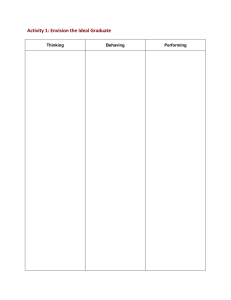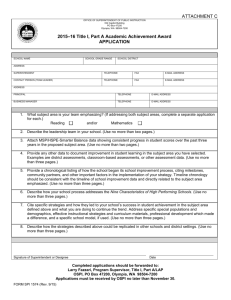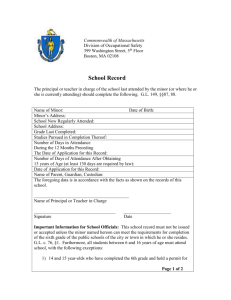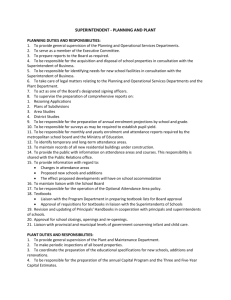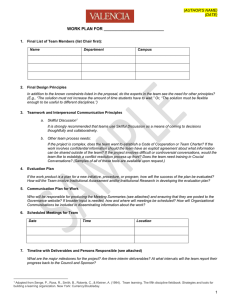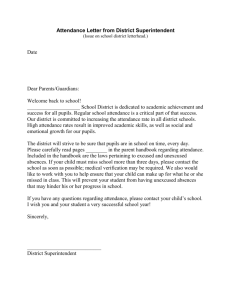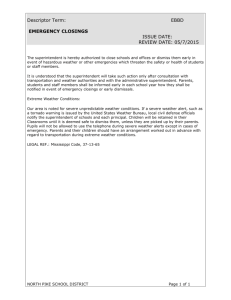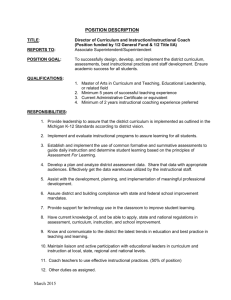School Improvement Plan - Atlanta Public Schools
advertisement
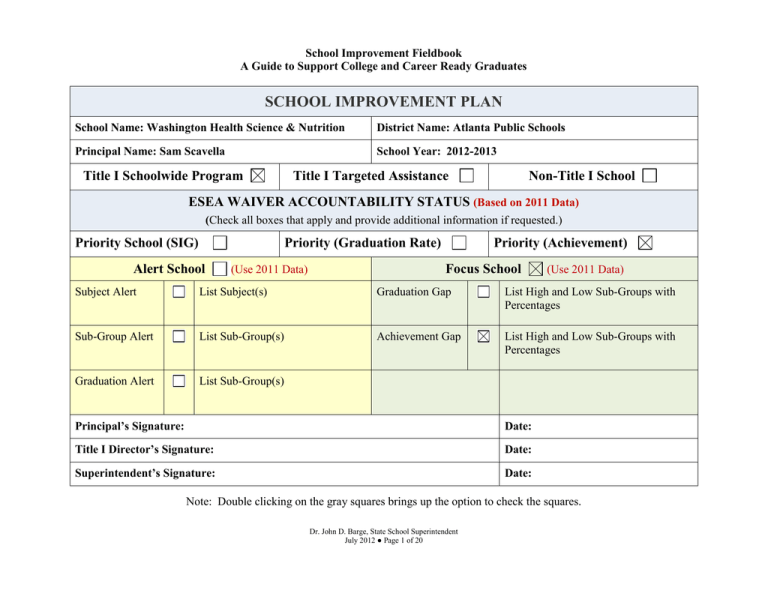
School Improvement Fieldbook A Guide to Support College and Career Ready Graduates SCHOOL IMPROVEMENT PLAN School Name: Washington Health Science & Nutrition District Name: Atlanta Public Schools Principal Name: Sam Scavella School Year: 2012-2013 Title I Schoolwide Program Title I Targeted Assistance Non-Title I School ESEA WAIVER ACCOUNTABILITY STATUS (Based on 2011 Data) (Check all boxes that apply and provide additional information if requested.) Priority School (SIG) Priority (Graduation Rate) Alert School (Use 2011 Data) Priority (Achievement) Focus School (Use 2011 Data) Subject Alert List Subject(s) Graduation Gap List High and Low Sub-Groups with Percentages Sub-Group Alert List Sub-Group(s) Achievement Gap List High and Low Sub-Groups with Percentages Graduation Alert List Sub-Group(s) Principal’s Signature: Date: Title I Director’s Signature: Date: Superintendent’s Signature: Date: Note: Double clicking on the gray squares brings up the option to check the squares. Dr. John D. Barge, State School Superintendent July 2012 ● Page 1 of 20 School Improvement Fieldbook A Guide to Support College and Career Ready Graduates SMART Goal: Increase the percentage of students meeting and exceeding standards on the Math II End of Course Test from 24% to 34% by the end of spring 2013. SMART Goal: In the inaugural year of assessment, 41% of students will meet and exceed standards on the CCGPS Algebra End of Course Test by the end of spring 2013. SMART Goal: Increase the percentage of students meeting and exceeding standards on the US History End of Course Test from 25% to 35% by the end of spring 2013. SMART Goal: In the inaugural year of assessment, percentage of students will meet and exceed standards on the Economics End of Course Test by the end of spring 2013. SMART Goal: Increase the percentage of students meeting and exceeding standards on the 9th Grade Literature End of Course Test from 48% to 58% by the end of spring 2013. SMART Goal: Increase the percentage of students meeting and exceeding standards on the American Literature End of Course Test from 70% to 80% by the end of spring 2013. SMART Goal: Increase the percentage of students meeting and exceeding standards on the Biology End of Course Test from 48% to 58% by the end of spring 2013. Dr. John D. Barge, State School Superintendent July 2012 ● Page 2 of 20 School Improvement Fieldbook A Guide to Support College and Career Ready Graduates School Keys Strands Curriculum Standard 1 Actions, Strategies, Interventions Teachers participate in developing curriculum maps/instructional focus calendars that provide the sequence of concepts, standards, and skills, and the time periods for teaching the content. Designated checkpoints using performance tasks, formative and summative assessments should be clear. A scope and sequence process or checklist is used to ensure that every element and standard will have designated instructional times within the maps. Some standards and elements require spiraling in the map design. Timeline Estimated Costs, Funding Sources, and Resources August No cost 30, 2012 – September 7, 2013 Person(s) Responsible Teacher Dr. John D. Barge, State School Superintendent July 2012 ● Page 3 of 20 Evaluation of Implementation and Impact on Student Learning Artifacts Evidence Curriculum Teachers are Maps/Instructional utilizing the Focus Calendars curriculum maps and instructional focus calendars to sequence lessons. Vertical and horizontal teacher teams are familiar with grade level content maps/instructional focus calendars and can articulate how they are utilizing them. School Improvement Fieldbook A Guide to Support College and Career Ready Graduates School Keys Strands Assessment Standard 2 Actions, Strategies, Interventions Grade level and content area teachers administer diagnostic assessments at the beginning of each unit of study to design instruction to build on student strengths, to clarify misconceptions, and introduce new or unknown concepts. Such assessments might include initial writing prompts, informal reading assessments, pretests, KWLs, anticipation guides, etc. Timeline Estimated Costs, Funding Sources, and Resources August 6, No cost 2012 – September 7, 2013 Person(s) Responsible Teacher Dr. John D. Barge, State School Superintendent July 2012 ● Page 4 of 20 Evaluation of Implementation and Impact on Student Learning Artifacts Evidence Diagnostic assessments Student results Instructional plans that address results, etc. Teacher can identify individual and class strengths, misconceptions, and areas of weakness. Teacher can explain how instruction has been designed to meet student needs based on the diagnostic assessment. School Improvement Fieldbook A Guide to Support College and Career Ready Graduates School Keys Strands Curriculum Standard 2 Actions, Strategies, Interventions Timeline Curriculum units are designed to include multiple tasks and assessments that require students to demonstrate an in-depth understanding through higher order thinking. For example, students are asked to explain the causes and effects of global warming as opposed to only being asked to define global warming. August 6, 2012 – May 22, 2012 Estimated Costs, Funding Sources, and Resources No cost Person(s) Responsible Teacher Dr. John D. Barge, State School Superintendent July 2012 ● Page 5 of 20 Evaluation of Implementation and Impact on Student Learning Artifacts Evidence Curriculum Units Teacher Assessments, etc. Student work samples Teachers and administrators understand that the goal is to teach fewer concepts but with a deeper understanding, as opposed to covering numerous concepts with no or limited understanding. School Improvement Fieldbook A Guide to Support College and Career Ready Graduates School Keys Strands Curriculum Standard 3 Actions, Strategies, Interventions Formative and summative assessment data are routinely disaggregated to adjust implementation of the curriculum and improve instruction. Timeline Estimated Costs, Funding Sources, and Resources September No cost 14, 2012 October 17, 2012 January 11, 2013 February 15, 2013 March 20, 2013 April 30, 2013 May 23, 2013 Person(s) Responsible Teacher Dr. John D. Barge, State School Superintendent July 2012 ● Page 6 of 20 Evaluation of Implementation and Impact on Student Learning Artifacts Evidence Disaggregated formative assessment results Disaggregated summative assessment results Disaggregated teacher made assessment results Rubrics Teacher/student conferencing notes/SSPs Teacher and other instructional leaders analyze their formative and summative assessment data and can show the areas of need for all students. Teacher can explain how their instructional plans are adjusted based upon assessment data and student work. Principal and other school leaders are aware of the students who are struggling to meet standard, as well as those who exceed the standard and monitor their progress during classroom visits. Teacher can articulate how instruction is revised as a result of disaggregated data. School Improvement Fieldbook A Guide to Support College and Career Ready Graduates School Keys Strands Actions, Strategies, Interventions Timeline Estimated Costs, Funding Sources, and Resources Person(s) Responsible Evaluation of Implementation and Impact on Student Learning Artifacts Evidence Assessment Standard 1 Student data from state assessment results (Writing Assessments, EOCT, etc.) is disaggregated to identify patterns for specific students or groups of students. Grade level and/or content area teachers and administrators collaborate to analyze data to determine learning priorities for the school improvement plan. August No cost 22, 2012 – September 14, 2012 Teacher Principal Instructional Coach Disaggregated test data Agendas and minutes Classroom profiles, etc. Assessment Standard 1 Performance targets are established to address student needs and desired outcomes at each grade level and/or content area. September No cost 14, 2012 October 17, 2012 January 11, 2013 February 15, 2013 March 20, 2013 April 30, 2013 May 23, 2013 Teacher Data room School Improvement Plan Grade/team plans Classroom profile sheets Performance targets Dr. John D. Barge, State School Superintendent July 2012 ● Page 7 of 20 Leadership and teacher can communicate the strengths and weaknesses identified in state assessment data at a variety of levels to include the school, individual grades, as well as classrooms. Teacher’s assessments address the performance targets. Teacher can discuss the performance targets and know which students are meeting or exceeding the targets, as well as which students need additional instruction. School Improvement Fieldbook A Guide to Support College and Career Ready Graduates School Keys Strands Assessment Standard 1 Actions, Strategies, Interventions The school leadership meets with individual teachers to review their grade level outcomes by content area and to discuss the teacher’s plan for meeting individual student academic needs. Timeline Estimated Costs, Funding Sources, and Resources September No cost 14, 2012 October 17, 2012 January 11, 2013 February 15, 2013 March 20, 2013 April 30, 2013 May 23, 2013 Person(s) Responsible Principal Leadership Team Teacher Dr. John D. Barge, State School Superintendent July 2012 ● Page 8 of 20 Evaluation of Implementation and Impact on Student Learning Artifacts Evidence Schedule of teacher meetings Leadershipteacher conference minutes Feedback forms Performance targets, etc. Teacher can articulate their grade level and classroom areas of focus and can describe their instructional goals for meeting individual student academic needs. Leadership can articulate the instructional focus for each grade level and monitor specific goals. School Improvement Fieldbook A Guide to Support College and Career Ready Graduates School Keys Strands Assessment Standard 3 Actions, Strategies, Interventions Timeline Students not meeting standard(s) are grouped according to assessment results and are assigned to safety net instruction, which occurs before, during, and after school. All extended learning sessions are monitored for effectiveness by analyzing data from assessments on a regular basis. August 6, 2012 – May 20, 2013 Estimated Costs, Funding Sources, and Resources No cost Person(s) Responsible Teacher Dr. John D. Barge, State School Superintendent July 2012 ● Page 9 of 20 Evaluation of Implementation and Impact on Student Learning Artifacts Evidence Safety net rosters Student data Other program rosters with assessment results Formative assessments Summative assessments, etc. Students who need additional assistance in meeting the standards are enrolled in safety nets. Safety net instruction is continuously monitored and teacher can explain how students are moved in and out of the program based on assessment results. School Improvement Fieldbook A Guide to Support College and Career Ready Graduates School Keys Strands Instruction Standard 2 Actions, Strategies, Interventions Timeline Teachers develop high-level questions for assessments as well as performance tasks that require critical thinking, application, etc. Teachers also utilize research-based instructional strategies and ask highlevel questions needed to assess students’ understanding of concepts during instruction. August 6, 2012 – May 20, 2013 Estimated Costs, Funding Sources, and Resources No cost Person(s) Responsible Teacher Dr. John D. Barge, State School Superintendent July 2012 ● Page 10 of 20 Evaluation of Implementation and Impact on Student Learning Artifacts Evidence Open-ended questions on assessments Performance tasks Rubrics Graphic organizers Classroom assessments Posted essential questions, standards, etc. Feedback Forms Teacher demonstrates effective research-based instructional strategies and can explain how an assessment, performance task, etc., emphasize higher-order thinking and result in student understanding. School Improvement Fieldbook A Guide to Support College and Career Ready Graduates School Keys Strands Instruction Standard 2 Actions, Strategies, Interventions Timeline Teachers participate in professional learning on differentiated instruction. Appropriate support and follow-up is planned quarterly by the leadership team and in collaborative teacher meetings. Follow-up support may include planning teacher meetings on management of formative assessment data to guide differentiated instruction, facilitating work groups, varying tasks, etc., scheduling demonstration lessons and teacher observations, videotaping classes for additional professional learning. August 6, 2012 – May 20, 2013 Estimated Costs, Funding Sources, and Resources $1,000 for books for study groups Person(s) Responsible Teacher Instructional Coach Principal Leadership Team Dr. John D. Barge, State School Superintendent July 2012 ● Page 11 of 20 Evaluation of Implementation and Impact on Student Learning Artifacts Evidence Professional learning schedules, sign in sheets, agendas and minutes Classroom arrangements Sample activities and performance tasks in lesson plans Group assignment charts Student choice of assignments, etc. Observations indicate students working toward the same standard but in varying ways. Instruction may be paced or presented differently; tasks may vary based on interest and student needs. Teacher can explain how data supports differentiated instruction. School Improvement Fieldbook A Guide to Support College and Career Ready Graduates School Keys Strands Instruction Standard 2 Actions, Strategies, Interventions Timeline Collaborative teacher meetings are held to determine the approximate reading level of resources (textbooks, software, etc.) and to review the reading levels of students. Follow-up teacher meetings are held to clarify how these two sources of information will be used to plan appropriate instruction, provide students with resources that are accessible, and develop reading strategies. August 6, 2012 – May 20, 2013 Estimated Costs, Funding Sources, and Resources $28,000 for software programs for students Person(s) Responsible Teacher Instructional Coach Leadership Team Dr. John D. Barge, State School Superintendent July 2012 ● Page 12 of 20 Evaluation of Implementation and Impact on Student Learning Artifacts Evidence Student reading level data (ex. Lexile, Dibles, Gates) Reading level text assessments Agendas and minutes form teacher meetings: -to determine reading levels of text -to plan appropriate instructional strategies Conference notebooks, etc. Teacher can demonstrate a method used to determine the reading level of their textbooks or other reading material. Teacher uses instructional strategies necessary for students to understand and apply standards when the textbook exceeds the student’s reading level (e.g., Read aloud-Think aloud, questioning the author, etc.) School Improvement Fieldbook A Guide to Support College and Career Ready Graduates School Keys Strands Professional Learning Standard 1 Actions, Strategies, Interventions Timeline Teachers are engaged in planning professional learning experiences for the school and articulate the intended results of professional learning. This includes working with the principal and other staff to develop plans for monitoring the implementation of classroom strategies, creating a system of follow-up support, and identifying the results of these strategies on student learning. August 6, 2012 – May 20, 2013 Estimated Costs, Funding Sources, and Resources $1,000 Person(s) Responsible Teacher Leadership Team Principal Dr. John D. Barge, State School Superintendent July 2012 ● Page 13 of 20 Evaluation of Implementation and Impact on Student Learning Artifacts Evidence School Improvement Plan which includes professional learning Evaluation of professional learning developed to demonstrate implementation and impact Awareness walk documentation Feedback form Student work Benchmark assessments, etc. School leaders and teacher can articulate what instructional strategies and practices are being implemented. School leaders and teacher can articulate the next steps for professional learning and for improving instruction. School leaders and teacher can articulate and show student work that is evidence that the implementation of these strategies has resulted in improving student learning. School Improvement Fieldbook A Guide to Support College and Career Ready Graduates SMART Goal: Decrease the percentage of students who have 10 unexcused absences from school from 42% to 22% by the end of spring 2013. School Keys Strands School Culture Student, Family, & Community Actions, Strategies, Interventions One the 1st & 2nd occasion that a student is absent from class, the teacher will call and counsel parents regarding the requirements to report to school regularly and on time. Contents of the conference must be documented. The attendance designee will mail a letter to the parents indicating the number of absences. These letters will be filed in the Attendance Office Clerk’s office. The student will have to serve a mandatory minor (30 minute) detention. Timeline Aug. 6 – May 20th Estimated Costs, Funding Sources, and Resources $2000 Dr. John D. Barge, State School Superintendent July 2012 ● Page 14 of 20 Person(s) Responsible Teacher Office Clerk Evaluation of Implementation and Impact on Student Learning Artifacts Evidence Contact Log Attendance letter Parents & students will be aware of daily attendance and the impact on student learning and success. School Improvement Fieldbook A Guide to Support College and Career Ready Graduates School Keys Strands School Culture Student, Family, & Community Actions, Strategies, Interventions Timeline On the 3rd & 4th occasion that a student is Aug. 6 – absent from class, a Social Worker referral May 20th must be completed and sent to the School Social Worker. In addition, the Attendance Office Clerk will call and counsel parents regarding the requirements for their child to report to school on time every day. The Attendance Office Clerk will conduct a Mandatory Attendance Meeting with the parents/guardians/student and complete the Compulsory Attendance Form and carefully document the contents of the conference and file a copy of that form in the Attendance Clerk’s Office. The student will serve a major (1 hour) detention with the grade level team. The school will initiate the SST process on the student. Estimated Costs, Funding Sources, and Resources No cost Dr. John D. Barge, State School Superintendent July 2012 ● Page 15 of 20 Person(s) Responsible Teacher Attendance Office Clerk Social Worker SST Chairperson Evaluation of Implementation and Impact on Student Learning Artifacts Evidence Social Worker Referral Contact log Student and parent will be held responsible for compulsory attendance and the student will demonstrate regular and punctual attendance as a result. School Improvement Fieldbook A Guide to Support College and Career Ready Graduates School Keys Strands School Culture Student, Family, & Community School Culture Student, Family, & Community Estimated Costs, Funding Sources, and Resources Person(s) Responsible Evaluation of Implementation and Impact on Student Learning Artifacts Evidence Actions, Strategies, Interventions Timeline On the 5th & 6th occasion that a student is absent, the teacher will notify the parent. The Attendance Office Clerk will contact the parents/guardians to conduct another attendance meeting. Attendance violation letters will be sent home. The student will attend Saturday School (3 hours) and/or ISS. Further documentation will be collected through the SST process. The School Social Worker will conduct a home visit, if necessary. On the 7th or more occasions that a student is absent, the teacher will complete another Social Worker Referral Form. The teacher will attach all the documents of previous actions taken to the referral. The School Social Worker will meet/counsel with the parent on the Attendance Policy and explain that any further absences will result in the filing of a petition in the Juvenile Court system. The parent will be provided services to assist the family with this issue. The Social Worker will carefully document the contents of the conference and file a copy of that form in the school Social Worker office. The student and parent will be notified that any further absences will result in a referral being made for a tribunal hearing for alternative school placement. Aug. 6 – May 10th $1000 Teacher Attendance Office Clerk Grade Level Administrator Contact logs Attendance Violation Letter Meeting minutes Aug. 6 – May 10th No cost Teacher Social Worker Grade Level Administrator Social Worker Referral Previous documents Meeting minutes Juvenile Petitions Dr. John D. Barge, State School Superintendent July 2012 ● Page 16 of 20 Student and parent are aware of attendance violation and make immediate steps to improve student attendance. Student and parent understands the importance of regular and punctual attendance and make steps to regulate student’s attendance. School Improvement Fieldbook A Guide to Support College and Career Ready Graduates SMART Goal: Ensure that 60% of parents/guardians are actively involved in the school and knowledgeable about school events and support mechanisms as evidenced by 75% of customer satisfaction surveys by the end of spring 2013. School Keys Strands Student, Family, & Community Involvement & Support Standard 1 Actions, Strategies, Interventions Timeline The school creates a standardsbased newsletter focusing on student work and progress toward meeting standards. The standardsbased newsletter informs parents of the school’s mission and progress in becoming a standards-based school. Student work that meets or progresses toward meeting the standard is highlighted in the newsletter. Parents are aware of upcoming events at the school that support and celebrate student progress toward meeting standards. Sept. 17th Dec. 3rd Feb. 4th Apr. 15th Estimated Costs, Funding Sources, and Resources $1000 Person(s) Responsible Grade Level Teams Instructional Coach Administration Dr. John D. Barge, State School Superintendent July 2012 ● Page 17 of 20 Evaluation of Implementation and Impact on Student Learning Artifacts Evidence Standards-based Newsletter Student work with commentary, etc. Teachers and parents can explain how their student/child is progressing towards meeting or exceeding the standards. School Improvement Fieldbook A Guide to Support College and Career Ready Graduates School Keys Strands Estimated Costs, Funding Sources, and Resources Person(s) Responsible Evaluation of Implementation and Impact on Student Learning Artifacts Evidence Actions, Strategies, Interventions Timeline Student, Family, & Community Involvement & Support Standard 1 The school creates a standardssnapshot by grade level that highlights student’s work and informs parents of the standards that their students are working toward. Aug. 6 – May 20th No cost Teacher Standardssnapshots Student work with commentary, etc. Student, Family, & Community Involvement & Support Standard 1 The school’s council meets consistently and has active parent, teacher, and community/business members’ participation. Sept. 18th Dec. 4th Feb. 5th Apr. 16th No cost Principal Elected Teachers Agenda and minutes, etc. Dr. John D. Barge, State School Superintendent July 2012 ● Page 18 of 20 Parents are aware of the standards that their children are working on in the classroom. Parents can identify how their children are progressing toward meeting the standards. Parents, teachers, community members, and principal participate in the school’s council. School Council members can articulate how they are involved in shared-decision making and how the decisions made at school council impact student learning. School Improvement Fieldbook A Guide to Support College and Career Ready Graduates School Keys Strands Estimated Costs, Funding Sources, and Resources Person(s) Responsible Actions, Strategies, Interventions Timeline Student, Family, & Community Involvement & Support Standard 1 The school has an active Parent/Student/Teacher organization similar to PTO/PTA. Sept. 18th Dec. 4th Feb. 5th Apr. 16th No cost Principal Teachers Support Staff Student, Family, & Community Involvement & Support Standard 1 The school offers scheduled informational sessions related to parenting skills to the community. Sept. 18th Dec. 4th Feb. 5th Apr. 16th No cost Principal Teachers Support Staff Dr. John D. Barge, State School Superintendent July 2012 ● Page 19 of 20 Evaluation of Implementation and Impact on Student Learning Artifacts Evidence Master schedule of meetings Meeting agendas and minutes Sign-in sheets, etc. Parent/Teacher organizational meetings are regularly scheduled. All stakeholders express how active parental involvement in the school impacts student learning. Parent Parents can invitation communicate and implement newly Flyers for the acquired community Dates on school strategies/topics/ideas from parenting skills marquee’ training. Parents Email explain how they communications support the school in Newsletters assisting their with listing of children with their events learning needs. Sign-in sheets Session agendas, etc. School Improvement Fieldbook A Guide to Support College and Career Ready Graduates School Keys Strands Estimated Costs, Funding Sources, and Resources Person(s) Responsible Actions, Strategies, Interventions Timeline Student, Family, & Community Involvement & Support Standard 2 The school offers a variety of volunteer opportunities for parents. Aug. 6 – May 20th No cost Home School Liaison Principal Support Staff Student, Family, & Community Involvement & Support Standard 3 The school counselor serves as a liaison with community agencies to provide services to student and parents. Aug. 6 – May 20th No cost School Counselor Principal Dr. John D. Barge, State School Superintendent July 2012 ● Page 20 of 20 Evaluation of Implementation and Impact on Student Learning Artifacts Evidence Volunteer notebooks maintained to indicate specific area (cafeteria, office, classroom, etc.) Evidence of media center time provided to/by parents, etc. Community service plan Community resource pamphlets Referral forms, documentation, etc. Parents can explain how the school involves parents through volunteer opportunities and how these volunteer opportunities directly support student learning. The school counselor is able to discuss the collaborative efforts with other community agencies to provide services to students and parents. They can articulate how these services support student relational, emotional, and academic needs.
